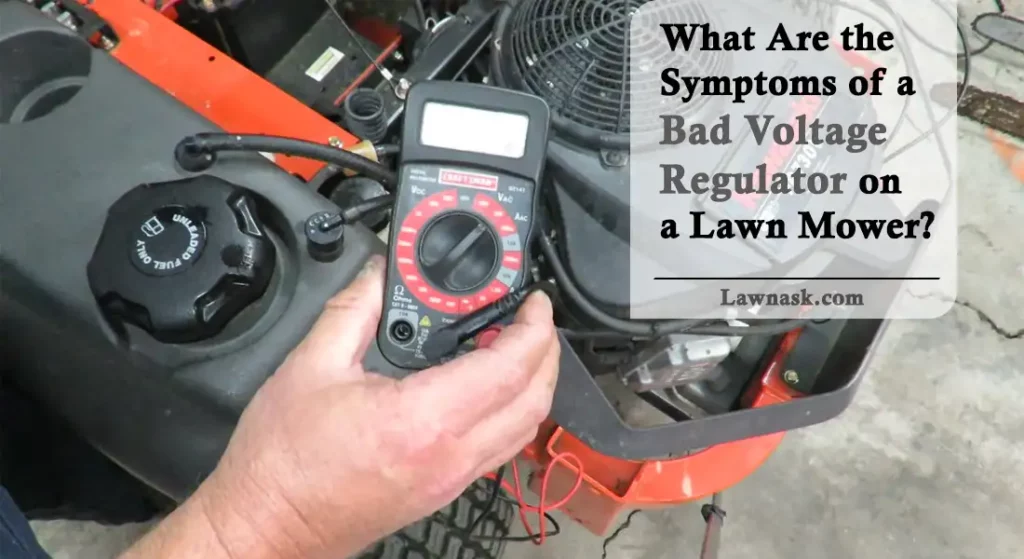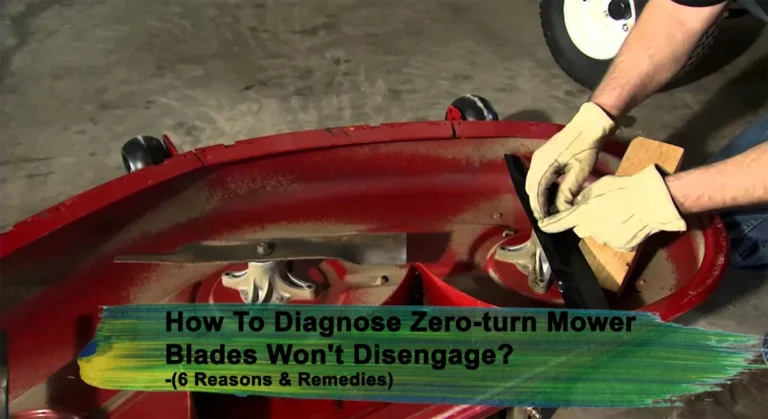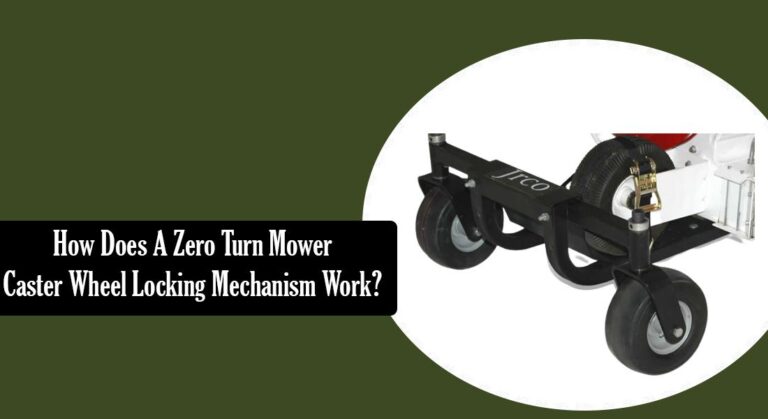Symptoms of a Bad Voltage Regulator on a Lawn Mower
A voltage regulator is an inherent part of your lawn mower’s electrical system. Without it, you can barely run your mower as it controls the charge uptake of your mower battery.
Easily the most prominent symptom of a bad voltage regulator is the battery not charging. This happens due to the lack of proper voltage going to the battery. An overcharged or undercharged battery is a sign.
But there are more symptoms which you’ll find surprising is even related to this problem. What are they? How do you troubleshoot it? Find out all the symptoms of a bad voltage regulator on a lawn mower in this article below.

The Role of the Voltage Regulator in a Lawn Mower’s Electrical System
The role of the voltage regulator in a lawn mower’s electrical system is to regulate the voltage output of the charging system. In short, it ensures that the battery receives the correct charge.
In most lawnmowers, the voltage regulator is situated on or near the engine, typically on the opposite side of the flywheel. It is often attached to the engine block or the mower’s frame with bolts. The location may vary in different make and models of the mowers.
The charging system of a lawn mower typically consists of an alternator or generator. It generates electricity as the engine runs.
The voltage regulator is responsible for controlling the voltage and current flow from the charging system to the battery and other electrical components.
A high voltage output of the charging system is lowered by the voltage regulator. This prevents overcharging of the battery and damage to the electrical components.
Similarly, if the voltage output is too low, the voltage regulator will increase it to ensure that the battery is properly charged. This also ensures that the electrical components receive enough power to operate correctly.
Read Also: Lawn Mower Ignition Switch Problems and How to Fix Them
Symptoms Of A Bad Voltage Regulator On A Lawn Mower
The surest symptoms of a bad voltage regulator on a lawnmower are given below:
- The battery does not charge. But if it does, it overcharges or undercharges.
- Regardless of throttle position, the mower runs at 12.4 volts. And the voltage drops when the blades are engaged.
- The voltage regulator gets very hot.
- Non-ideal voltage when the tests discussed above are conducted.
The voltage tests can be a way to determine if your battery is taking charge or not.
How to Test If the Lawn Mower Battery Has the Proper Voltage?
The typical thing to do is to unplug the regulator and check for battery voltage on the center wire. On Kohler and similar mowers, this wire should be purple.
No voltage on the purple wire means you are not connected to the battery. And you can’t charge a battery you aren’t connected to.
You can check for voltage continuation in this wire. This is how:
- Take a multimeter set on AC volts.
- Put a lead on each white wire on the regulator plug.
- Start the engine and rev it up.
- You should get a reading of 32 volts or above.
If you don’t get this voltage, the regulator might be the problem. Make sure the regulator is grounded.
Another way to test the regulator is as follows:
- Run the engine at full throttle.
- Check the voltage of the battery
- If all you get is a battery voltage of 12 volts or so then you may have a problem.
- In case you get a reading of say 13 or 14 volts then the charging system is working.
Kohler does make a tester for regulators part number 25 761 20-S. But it is costly and will set you back for about $90.
Pseudo-Symptoms of a Bad Voltage Regulator on a Lawn Mower
The problem with voltage regulators going bad is that there are no tests to check if they’re bad. You have to rely heavily on the symptoms. So, its very easy to get misled.
So, these symptoms that can be passed as ‘pseudo’ ones, are as follows:
Starter motor problems: A faulty starter solenoid, weak battery, or other issues cause starter motor issues. While a bad voltage regulator can cause a weak battery, it is not usually the primary cause of starter motor problems.
Electrical system failures: Blown fuses, damaged wiring, or malfunctioning switches can be caused by several factors. These include poor maintenance, wear, and tear, or electrical overload. A bad voltage regulator does not cause these electrical system failures.
Fuel system problems: Clogged fuel filters, dirty carburetors, or bad fuel pumps, can cause difficulty starting, poor engine performance, and stalling. A bad voltage regulator can cause these symptoms indirectly by not supplying enough voltage to the ignition system. Yet, it is not the primary cause of fuel system problems.
Why Does a Voltage Regulator Go Bad on Your Lawn Mower?
A regulator can fail due to two factors. One is a bad stator. The second issue is a lack of solid ground on the regulator. The stator is responsible for generating the electrical charge that the voltage regulator regulates.
So a bad stator can cause the voltage regulator to fail. Test the stator for voltage, continuity and resistance with a multimeter. Then match the results with your instruction manual to diagnose the stator.
If the ground is not constant, the regulator will operate incorrectly and short out. You may add a second ground wire to regulators to ensure that they are always grounded.
Read Also: What Causes A Lawn Mower To Leak Oil?
How to Replace a Bad Voltage Regulator on Your Lawn Mower?
The solution to a bad voltage regulator is to replace it. Here’s how to do that:
- Get the tools: You will need a set of wrenches or sockets to remove the old voltage regulator and install the new one. Check your owner’s manual if you need any other tools.
- Disconnect the battery: Disconnect the negative cable from the battery to avoid any electrical shocks or short circuits. Do this before doing anything else.
- Remove the old voltage regulator: Use a wrench or socket to remove the bolts or screws that hold the old voltage regulator in place. Carefully disconnect the wiring harness from the old regulator.
- Install the new voltage regulator: Attach the wiring harness to the new voltage regulator and secure it in place with the bolts or screws.
- Reconnect the battery: Reconnect the negative cable to the battery and ensure that all electrical connections are tight.
- Test the new voltage regulator: Start the mower and test the voltage output of the new voltage regulator using a multimeter. The voltage should be between 13.5 and 14.5 volts
If all this is done, you are good to go. If your voltage regulator goes bad frequently, then change the stator along with it. And hopefully, the issue will be fixed.
Frequently Asked Questions (FAQs)
How much does it cost to replace a voltage regulator on a lawn mower?
The cost of replacing a voltage regulator on a lawn mower can vary depending on the make and model of the mower and the cost of the replacement part. However, on average, it can cost between $30 to $100 for the part. The labor costs can range from $50 to $150.
Is it safe to use a lawn mower with a bad voltage regulator?
No. It is not recommended to use a lawn mower with a bad voltage regulator as it can cause damage to the battery and other electrical components of the mower.
Can a bad voltage regulator drain a lawn mower battery?
Yes, a bad voltage regulator can cause the battery on a lawn mower to drain due to inconsistent charging or overcharging.
How long does a voltage regulator on a lawn mower last?
The lifespan of a voltage regulator on a lawn mower can vary depending on usage and environmental factors. But they typically last several years.
Related Posts:
- Identifying Signs of a Blown Head Gasket in a Kohler Engine
- Recognizing the Symptoms of a Faulty Alternator on a Riding Lawn Mower
- Pros and Cons of Rear Discharge Mowers, Explained
- Ignition Coil Kill Wire Unveiled: The Ultimate Guide to Lawn Mower Ignition Systems
- Zero Turn Mower Tips: Step-by-Step Guide to Putting Your Mower in Neutral






